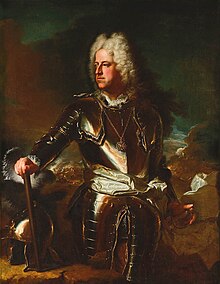Ferdinando Carlo by Gonzaga-Nevers

Ferdinando Carlo von Gonzaga-Nevers (born August 31, 1652 in Revere , † July 5, 1708 in Padua ) was the last Duke of Mantua and Montferrat and Prince of Arches from the Gonzaga family . He is sometimes referred to as Carlo (dt. Karl ) IV .
Life
Ferdinando Carlo was the only child of Duke Carlo II of Mantua and Montferrat . When Ferdinando died in August 1665, Ferdinando was barely 13 years old and was therefore still under the tutelage of his mother Isabella Clara of Austria (1629–1685), a niece of Emperor Ferdinand II. In August 1669 , when he succeeded him Ferdinando formally took over the business of government himself, but his mother still exercised a decisive influence. However, since she was striving for more independence from the emperor, the Viennese government used her love affair with Count Bulgarini as an excuse to obtain a papal order to place the duchess in a monastery and thus prevent her from participating in the Mantuan government. Count Gottlieb Amadeus von Windisch-Graetz was commissioned with the execution as the imperial commissioner.
On December 8, 1678, Ferdinando Carlo signed a contract with Louis XIV on the transfer of the important Piedmontese fortress Casale to France for money. The minister of Duke Count Ercole Antonio Mattioli (1640–1694) betrayed the secret treaty but a. to the Duchess of Savoy and Venice, which is why this initially failed, and was therefore imprisoned in Pinerolo on behalf of the angry Louis XIV in April 1679 (some authors saw him as a candidate for the man with the iron mask , who was temporarily in the same prison sat). Gonzaga denied everything, in 1681 signed a new treaty with France in return for the promise of "centomila pistole", an annual pension of 60,000 lire, a career as a general in the event of war and the surrender of part of the eventual conquests. On September 29, 1681, the French marched into Casale, which was then converted into a powerful fortress by Vauban. The Venetian Senate immediately forbade Gonzaga all relations with the “nobles” of the republic and denied him all honors.
Gonzaga made further headlines in 1685 because of a dispute with Johann Georg III. von Sachsen , who kidnapped the singer Margherita Salicola in Venice , whom Gonzaga claimed for herself; the Venetians sided with Saxony, who was able to take the singer with him to Dresden. Ferdinando Carlo also sponsored numerous other singers, including celebrities such as Maria Maddalena Musi and the castrato Domenico Cecchi called " Cortona ".
In 1700 Tomaso Albinoni dedicated his Op. 2 symphony e concerti a cinque .
Since Ferdinando Carlo Gonzaga sided with France in the War of the Spanish Succession , Emperor Joseph I had his Fahnlehen Duchy of Mantua withdrawn in front of the Reichstag in Regensburg on June 30, 1708 , after Emperor Leopold had already declared him a traitor in 1701. Mantua became an imperial land, which the emperor incorporated into his possession, Savoy now also received the second half of Montferrat (it had owned the first half since the War of the Mantuan Succession ). Ferdinando Carlo died only a few days later in Padua.
Family and offspring
Ferdinando Carlo married Anna Isabella Gonzaga († August 11, 1703), daughter of Duke Ferrante III , in 1670 . Gonzaga of Guastalla . On November 8, 1704 he married a second time, now Susanne Henriette von Lothringen-Elboeuf (February 1, 1686, † December 19, 1710), daughter of Charles III. de Lorraine, duc d'Elbeuf . Both marriages remained childless.
However, some illegitimate descendants are known:
- Giovanni Gonzaga (born July 26, 1671 - † October 27, 1743)
- Giovanna Gonzaga (* unknown, † 1739); ∞ Counts of Bardoxi
- Clara Clarina Gonzaga (* 1686; † 1749), nun ( Capuchin ) in Mantua
- Carlo Gonzaga (* 1692; † 1771), governor of various places in the Papal States , canon at the Roman St. Peter's Church , chamber cleric
- Isabella Clara Gonzaga (* 1694; † 1753), Terziarierin the Serve di Maria in Mantua
- Maria Elisabetta Gonzaga (* 1695; † after 1750), nun ( Capuchin ) in Mantua
Individual evidence
- ↑ Dino Gribaudi, Mario Attilio Levi: Storia del Piemonte . Casanova, Turin 1960, vol. 1, p. 223.
- ^ Enciclopedia Italiana
- ↑ Michael Strich : The dispute between Electoral Saxony and Mantua about the first prima donna in Germany (Margarita Salicola) . In: Historische Zeitschrift , Vol. 138 (1928), pp. 504-522.
literature
- G. Benzoni, Ferdinando Carlo Gonzaga Nevers , in: Dizionario Biografico degli Italiani 46, Roma: Istituto dell'Enciclopedia Italiana 1996, pp. 283-294;
- A. Cont, Sotto tutela: il sovrano bambino in Italia (1659-1714) , “ Rivista Storica Italiana ”, 124, 2 (agosto 2012), pp. 537-581.
Web links
| predecessor | Office | successor |
|---|---|---|
| Carlo II |
Duke of Mantua 1665–1708 |
Joseph I., Roman-German Emperor |
| Carlo II |
Duke of Montferrat 1665–1708 |
Viktor Amadeus II |
| personal data | |
|---|---|
| SURNAME | Gonzaga-Nevers, Ferdinando Carlo von |
| BRIEF DESCRIPTION | Duke of Mantua and Montferrat |
| DATE OF BIRTH | August 31, 1652 |
| PLACE OF BIRTH | Revere |
| DATE OF DEATH | July 5, 1708 |
| Place of death | Padua |